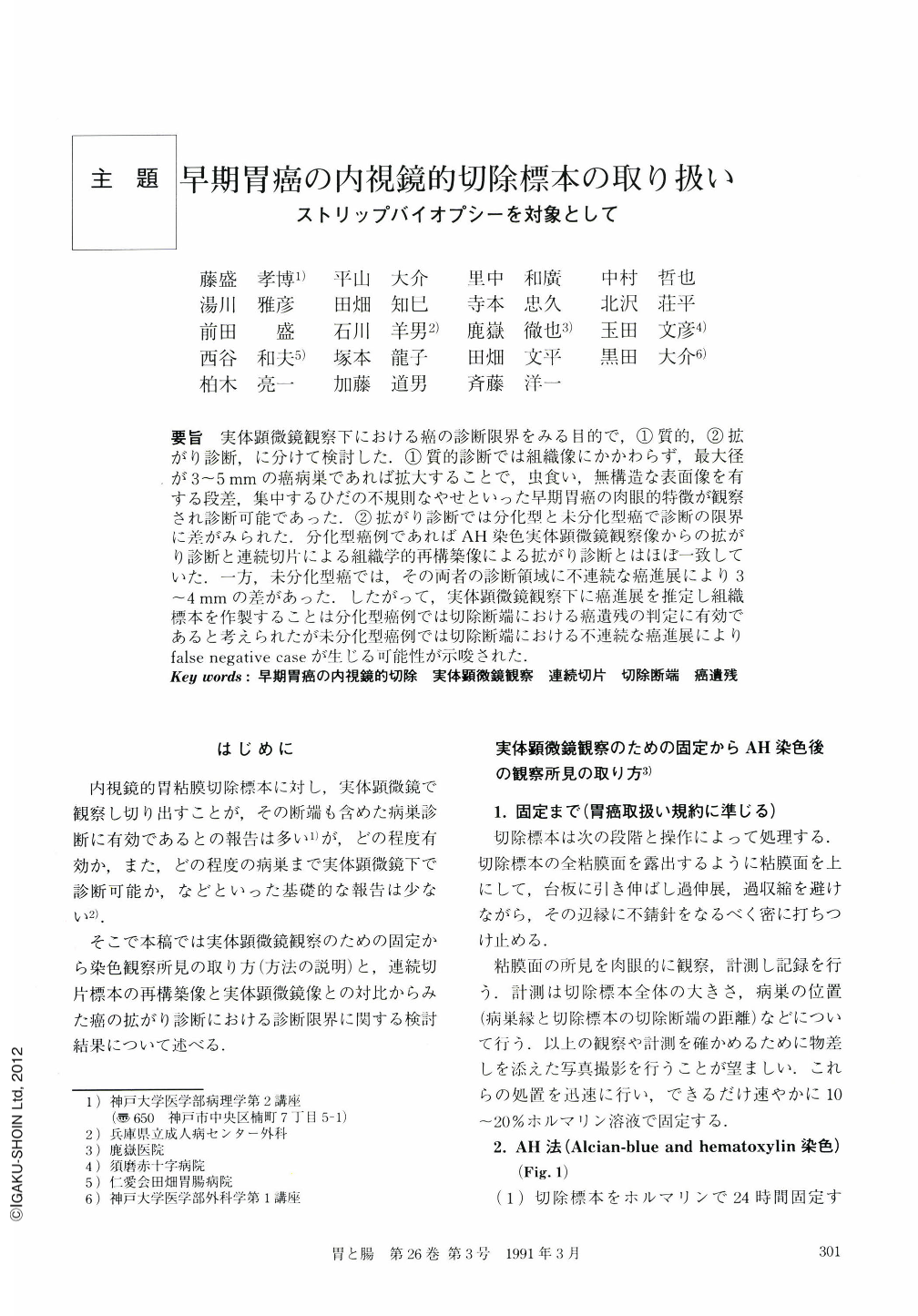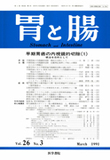Japanese
English
- 有料閲覧
- Abstract 文献概要
- 1ページ目 Look Inside
- サイト内被引用 Cited by
要旨 実体顕微鏡観察下における癌の診断限界をみる目的で,①質的,②拡がり診断,に分けて検討した.①質的診断では組織像にかかわらず,最大径が3~5mmの癌病巣であれば拡大することで,虫食い,無構造な表面像を有する段差,集中するひだの不規則なやせといった早期胃癌の肉眼的特徴が観察され診断可能であった.②拡がり診断では分化型と未分化型癌で診断の限界に差がみられた.分化型癌例であればAH染色実体顕微鏡観察像からの拡がり診断と連続切片による組織学的再構築像による拡がり診断とはほぼ一致していた.一方,未分化型癌では,その両者の診断領域に不連続な癌進展により3~4mmの差があった.したがって,実体顕微鏡観察下に癌進展を推定し組織標本を作製することは分化型癌例では切除断端における癌遺残の判定に有効であると考えられたが未分化型癌例では切除断端における不連続な癌進展によりfalse negative caseが生じる可能性が示唆された.
In the present paper, we compare and contrast the image reconstructed from serial sections and the image obtained though dissecting microscopy, as a means to diagnose the quality and spread of cancer cells. We describe the limitations of the latter method (AHmethod).
1. Qualitative diagnosis.
The observations of dissecting microscopy permit a qualitative diagnosis of lesions whose maximum major diameter is 3-5 mm longer than those able to be observedly histological serial section.
2. Spreaddiagnosis.
In order to determine the degree of discrepancy between the results of observations by dissecting microscopy and those made in histological samples we compared and contrasted the histologically reconstructed image of serial sections and the dissecting microscopic images obtained from two cases of undifferentiated carcinoma and three cases of differentiated carcinoma. In the differentiated carcinoma cases, the error betwewen the extension of carcinoma determined by dissecting microscopy and the reconstructed image of serial sections was within approximately 1 mm or less. On the other hand, however, undifferentiated carcinoma was found to have spread more extensively than was able to be estimated by dissecting microscopy;the error was 3-4 mm.
From these findings, it was concluded that in differentiated carcinoma cases, the extension of carcinoma spread was diagnosed as being almost the same, no matter which of the two methods were used. It was thought that remnant cancer cells need not be taken into consideration as long as there is a space of more than approximately 1 mm from the cut end during dissecting microscopic observation (about the width of two to three gastric glands). In the case of undifferentiated carcinoma, on the other hand, it was suggested that cases may bediagnosed as negative by dissecting microscopy, but, in step-sections sliced parallel to the major axis of the lesion, there may be positive indications of spread.
Because of this, the method in which tissue sections are observed under the dissecting microscopy is effective in the evaluation of differentiated carcinoma. However, for the complete resection of the carcinoma in the case of undifferentiated carcinoma, this methodology raises some problems. There is difficulty in the interpretation of the extent of the remnant of a carcinoma present in the cut end during ordinary pathological examination.

Copyright © 1991, Igaku-Shoin Ltd. All rights reserved.


